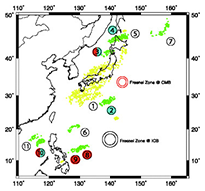** Progress in Earth and Planetary Science is the official journal of the Japan Geoscience Union, published in collaboration with its 51 society members.
** Progress in Earth and Planetary Science is partly financially supported by a Grant-in-Aid for Publication of Scientific Research Results to enhance dissemination of information of scientific research.
Gallery View of PEPS Articles
Research
Solid earth sciences
201511201511
Complex inner core boundary from frequency characteristics of the reflection coefficients of PKiKP waves observed by Hi-net
Tanaka S, Tkalčić H
Inner core boundary, Topography, PKiKP, Finite difference modeling
Ray paths of PcP and PKiKP seismic phases. A cross-section of Earth with ray paths of PcP and PKiKP seismic phases originating at the source (star), and recorded by a station at the Earth’s surface.
Summary map of frequency characteristics of P-wave reflection coefficients at the ICB. Distribution of the reflection points of PKiKP waves at ICB (green dots), and “Result numbers” indicating their frequency characteristics by colors. White: almost flat spectrum; blue: spectrum with a spectral hole; red: spectrum with a spectral peak; half red and blue: both a hole and a peak. Yellow dots indicate the exit and entrance points of PKiKP at the CMB. Double black and red circles are Fresnel zones at the ICB and CMB, respectively. Inner and outer circles are Fresnel zone estimates for 2 and 1 Hz, respectively.
Frequency-dependent reflection coefficients of P waves at the inner core boundary (ICB) are estimated from the spectral ratios of PKiKP and PcP waves observed by the high-sensitivity seismograph network (Hi-net) in Japan. The corresponding PKiKP reflection locations at the ICB are distributed beneath the western Pacific. At frequencies where noise levels are sufficiently low, spectra of reflection coefficients show four distinct sets of characteristics: a flat spectrum, a spectrum with a significant spectral hole at approximately 1 or 3 Hz, a spectrum with a strong peak at approximately 2 or 3 Hz, and a spectrum containing both a sharp peak and a significant hole. The variety in observed spectra suggests complex lateral variations in ICB properties. To explain the measured differences in frequency characteristics of ICB reflection coefficients, we conduct 2D finite difference simulations of seismic wavefields near the ICB. The models tested in our simulations include a liquid layer and a solid layer above the ICB, as well as sinusoidal and spike-shaped ICB topography with varying heights and scale lengths. We find that the existence of a layer above the ICB can be excluded as a possible explanation for the observed spectra. Furthermore, we find that an ICB topographic model with wavelengths and heights of several kilometers is too extreme to explain our measurements. However, restricting the ICB topography to wavelengths and heights of 1.0–1.5 km can explain the observed frequency-related phenomena. The existence of laterally varying topography may be a sign of lateral variations in inner core solidification.







